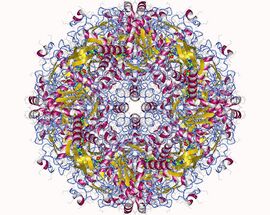Biology:Alcohol oxidase
| alcohol oxidase | |||||||||
|---|---|---|---|---|---|---|---|---|---|
 Alcohol oxidase homooctamer, Komagataella pastoris | |||||||||
| Identifiers | |||||||||
| EC number | 1.1.3.13 | ||||||||
| CAS number | 9073-63-6 | ||||||||
| Databases | |||||||||
| IntEnz | IntEnz view | ||||||||
| BRENDA | BRENDA entry | ||||||||
| ExPASy | NiceZyme view | ||||||||
| KEGG | KEGG entry | ||||||||
| MetaCyc | metabolic pathway | ||||||||
| PRIAM | profile | ||||||||
| PDB structures | RCSB PDB PDBe PDBsum | ||||||||
| Gene Ontology | AmiGO / QuickGO | ||||||||
| |||||||||
In enzymology, an alcohol oxidase (EC 1.1.3.13) is an enzyme that catalyzes the chemical reaction
- a primary alcohol + O2 [math]\displaystyle{ \rightleftharpoons }[/math] an aldehyde + H2O2
Thus, the two substrates of this enzyme are primary alcohol and O2, whereas its two products are aldehyde and H2O2.
This enzyme belongs to the family of oxidoreductases, specifically those acting on the CH-OH group of the donor with oxygen as the acceptor. It employs one cofactor, FAD.
Name
The systematic name of this enzyme class is alcohol:oxygen oxidoreductase. This enzyme is also called methanol oxidase and ethanol oxidase. Sometimes, this enzyme is called short-chain alcohol oxidase (SCAO) to differentiate it from long-chain-alcohol oxidase (LCAO), aryl-alcohol oxidase (AAO) and secondary-alcohol oxidase (SAO).[1]
Reaction
Alcohol oxidases catalyzes the oxidation of primary alcohols to their corresponding aldehydes. Unlike alcohol dehydrogenases, they are unable to catalyze the reverse reaction. This is reflected in their cofactor as well—unlike alcohol dehydrogenases, which use NAD+, alcohol oxidases use FAD.[1] SCAO is capable of oxidizing alcohols with up to 8 carbons, but their primary substrates are methanol and ethanol.
Known inhibitors of this enzyme include H2O2, Cu2+, phenanthroline, acetamide, potassium cyanide, or cyclopropanone.[1]
Properties
SCAO is an intracellular enzyme.[1] Its common source are fungi and yeasts, but it has also been shown to be present in mollusks.[1]
It appears as an octameric protein, except for SCAO from A. ochraceus, which has been shown to be a tetramer. Each of the subunites is 65-80 kDa. Nine SCAO isoforms have been found in Ogataea methanolica, which has been shown to be a result of different combinations of two different subunits in the octamers, each coded by a different gene.[1]
Structural studies
As of late 2007, 9 structures have been solved for this class of enzymes, with PDB accession codes 1AHU, 1AHV, 1AHZ, 1VAO, 1W1J, 1W1K, 1W1L, 1W1M, and 2VAO.
Potential use
Several potential uses have been suggested for SCAO:
- Biosensors with amperometric detection can be used within beverage testing, fermentation monitoring, methanol and ethanol detection, body fluid screening, and toxicological and phorensic laboratories[1]
- Chemical synthesis of various aldehydes including aroma and flavor chemicals, where it could appear as a cheaper and more eco-friendly alternative to current methods[1]
References
- ↑ 1.0 1.1 1.2 1.3 1.4 1.5 1.6 1.7 Goswami, Pranab; Chinnadayyala, Soma Sekhar R.; Chakraborty, Mitun; Kumar, Adepu Kiran; Kakoti, Ankana (May 2013). "An overview on alcohol oxidases and their potential applications" (in en). Applied Microbiology and Biotechnology 97 (10): 4259–4275. doi:10.1007/s00253-013-4842-9. ISSN 0175-7598. PMID 23525937. http://link.springer.com/10.1007/s00253-013-4842-9.
- "Alcohol oxidase, a flavoprotein from several Basidiomycetes species Crystallization by fractional precipitation with polyethylene glycol". Biochim. Biophys. Acta 151 (2): 330–42. 1968. doi:10.1016/0005-2744(68)90100-9. PMID 5636370.
- "Studies on enzymes related to lignan biodegradation". Baiomasu Henkan Keikaku Kenkyu Hokoku: 38–59. 1987.
- Suye S (1997). "Purification and properties of alcohol oxidase from Candida methanosorbosa M-2003". Curr. Microbiol. 34 (6): 374–7. doi:10.1007/s002849900198. PMID 9142745.
 |


